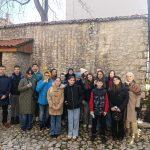Since its establishment, the nucleus of the Museum of the City of Sarajevo has been the Historical Collection, composed of two primary collections: the Austro-Hungarian Period Collection and the Sarajevo Assassination Collection. During the era of "real socialism," historical narratives were heavily influenced by social revolutions and class struggles, often presenting a selective view of events. This resulted in an overemphasis on some aspects while obscuring others. For instance, the assassination of the Austro-Hungarian heir to the throne, Franz Ferdinand, and his wife Sofia, orchestrated by the ultra-nationalist, large-state paramilitary intelligence organization "Black Hand," was falsely attributed to the fictional revolutionary organization "Mlada Bosna." This narrative framed "Mlada Bosna" as an idealistic revolutionary Yugoslav youth organization. As a result of this narrative, when the People's Committee of the City of Sarajevo allocated part of the building in front of which the assassination took place to the Museum, the Museum of Young Bosnia and Gavrilo Princip was established on June 28, 1953.
The Austro-Hungarian rule in Bosnia and Herzegovina was depicted in a socialist-dogmatic manner, often summarized by the phrase, "we had nothing, and then the hateful occupier took everything from us." This is perhaps best illustrated by the fact that when the Museum mounted the permanent exhibition "From Prehistory to the 20th Century" in 1954, the period of Austro-Hungarian rule in Bosnia and Herzegovina was completely omitted. The author of the exhibition even received the April 6 Award of the City of Sarajevo despite this glaring omission. Forty years after the foundation of the Museum (in 1989), the Collection of the Austro-Hungarian Period was formed, incorporating the Sarajevo Assassination Collection and accompanying legacies from Nikola Trišić, Kosta Mandić, Sima Simić, and Vladimir Lebedev, as well as legacies from notable Sarajevo families: Despić, Skarić, Besarović, Škaljić, and Jeftanović.
The collection includes government seals, military maps, transcripts from parliamentary sessions, blueprints of certain Sarajevo buildings, photographs, a significant number of books and magazines in both German and local language related to Sarajevo and Bosnia and Herzegovina, as well as clothing and weapons belonging to Austrian officials. It also features an "Austrian room" in the Biedermeier style, porcelain coffee and dining tableware from the "Konak," the Karađoz Theater, and documentary material about the occupation, annexation, military maneuvers, the visit of the imperial couple Ferdinand and Sofia to Sarajevo, the trial and execution of the assassins, among other items. The collection boasts a total of about 4,000 items.
Following the aggression against the Republic of Bosnia and Herzegovina, the Sarajevo Canton Assembly assumed the founding rights of the Museum and decided to rename the Museum of Young Bosnia and Gavrilo Princip to the Museum of Sarajevo 1878‒1918. Consequently, in 2006, an integral exhibition covering the entire Austro-Hungarian period from the occupation to the end of World War I (1878‒1918) was established.
The "Karađoz Theater" collection was renamed the Hasib Ramić's Collection in 2008, in honor of Hasib Ramić, the last performer of this shadow theater and the first magician in Sarajevo and Bosnia and Herzegovina. His legacy includes the Karađoz theater and magician's props.
Several thematic exhibitions and performances have been organized from the Collection of the Austro-Hungarian Period:
- Exhibition "Austro-Hungarian Architecture in Sarajevo," Linz Town Hall, 2007
- Exhibition "View of Sarajevo through the eyes of an Austro-Hungarian soldier," City Hall of Linz, 2009
- Exhibition "130 Years Since the Occupation and 100 Years Since the Annexation of Bosnia and Herzegovina," May 2008
- Exhibition "Sarajevo 1878‒1918," part of the "Days of Sarajevo in Vienna" event, 2008
- Exhibition "Dr. Dorner," May 2012
- Exhibition "Hasib Ramić - Karađoz and Magician," January 2013
- Exhibition "Fehim Ćurčić," May 2014
- Exhibition "Mehmed Spaho," May 2015
- Performance "Karađoz" at Svrzo's House, 2017
- Performance "Karađoz" at Hadžihalilović's House, Novi Grad Sarajevo, 2017
- Performance "Karađoz" at Ras Museum in Novi Pazar, 2023
- Performance "Karađoz" at Despić's House, 2024
- Exhibition "110 Years of the Sarajevo Assassination: Visitors on the Museum," 2024



